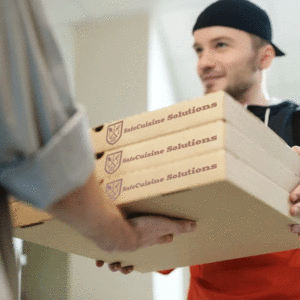
The rapid rise of food delivery services has transformed the way we dine, providing convenience and access to a wide range of culinary options. However, this shift in the food industry landscape also brings unique challenges in maintaining food safety throughout the delivery process. Ensuring that food remains safe and of high quality from the restaurant kitchen to the customer’s doorstep requires careful attention and innovative solutions. In this blog post, we will explore the challenges associated with food safety in the era of food delivery services and discuss effective strategies to overcome them.
Challenges in Food Safety for Delivery Services:
- Temperature Control: Maintaining optimal temperature control is crucial to prevent foodborne illnesses. The delivery process introduces additional risks, as food may spend more time in transit, potentially compromising its temperature. Ensuring that hot foods remain hot and cold foods stay cold throughout the delivery is a critical challenge for food safety.
- Cross-Contamination: Delivery services involve handling food items from multiple sources, increasing the risk of cross-contamination. This includes the potential for contact between raw and cooked foods, allergen cross-contact, or contamination from delivery packaging or delivery personnel. Effective measures must be implemented to minimize cross-contamination risks during the delivery process.
- Safe Packaging and Handling: Proper packaging and handling are essential to maintain food safety during delivery. Ensuring that food containers are leak-proof, tamper-evident, and suitable for maintaining temperature integrity is vital. Delivery personnel should be trained on safe handling practices, including hygiene, avoiding contact between food and non-food items, and proper vehicle sanitation.
- Delivery Time and Distance: Longer delivery times or extended distances can impact food safety. The longer food remains in transit, the greater the risk of temperature abuse or quality deterioration. Managing delivery logistics, optimizing routes, and employing efficient delivery systems are key to mitigating risks associated with time and distance.
Solutions for Ensuring Food Safety in Delivery Services:
- Robust Packaging: Utilize high-quality packaging materials that are designed to maintain temperature integrity and prevent cross-contamination. Insulated containers, tamper-evident seals, and spill-proof compartments can help preserve food safety during transit.
- Temperature Monitoring: Implement real-time temperature monitoring systems for delivery vehicles and packaging. This allows for constant monitoring of food temperatures, ensuring that hot foods are kept hot and cold foods remain properly chilled throughout the delivery process.
- Hygiene and Training: Provide comprehensive training to delivery personnel on food safety practices, including proper hand hygiene, safe handling, and avoiding cross-contamination. Regular training sessions and ongoing monitoring can help reinforce good practices.
- Efficient Delivery Logistics: Optimize delivery routes and timeframes to minimize the duration and distance of food transportation. Utilize technology and data analytics to streamline operations, ensuring that deliveries are prompt and efficient, reducing the risk of temperature abuse and maintaining food quality.
- Communication and Transparency: Foster open communication with customers by providing clear information on food safety measures taken during delivery. This includes informing customers about temperature control practices, safe packaging, and steps taken to prevent cross-contamination. Encourage customers to provide feedback to further enhance the safety of the delivery process.
Food delivery services offer convenience and accessibility, but they also introduce unique challenges in maintaining food safety. By recognizing and addressing these challenges with innovative solutions, the industry can ensure that food remains safe, fresh, and of high quality throughout the delivery process. Implementing robust temperature control, effective packaging, proper handling, and efficient delivery logistics are crucial steps in safeguarding food safety in the era of food delivery services. Together, let’s embrace these solutions and create a future where food delivery is synonymous with excellence in food safety and customer satisfaction.

